Wouldn't it be wonderful, if one day there would be no need for animal shelters in the world anymore? If profound spay/neuter-campaigns and educational work on site would create acceptance and responsibility, so that the street animals could live a free life?
You see animals living on the street all over the world, millions of them – for most people they are annoying or simply a “nuisance”. The usual solution would be:
– to capture them (often by using the most brutal methods)
– lock them up (in a national or a private animal shelter, a place where they can pretty much NEVER be kept in a species-appropriate way)
– wait (and see if somebody might want to take care of the strays after all and adopts them)
– often they get put down in the end anyway, because all the free places are needed for the many new arrivals, or the dogs vegetate behind bars for years on end
– comprehensive poisoning- and killing campaigns against street animals are unfortunately still executed in many countries
And are the streets emptier of strays? Usually not, because the free spaces are immediately filled by new animals.
Is this the right way to treat animals? Should humans disregard the lives of animals in this way? We think not. But what could be the “right” way to solve this problem? My husband Buschi and I emigrated from Germany to the Dominican Republic in January 2004 to take up this issue.
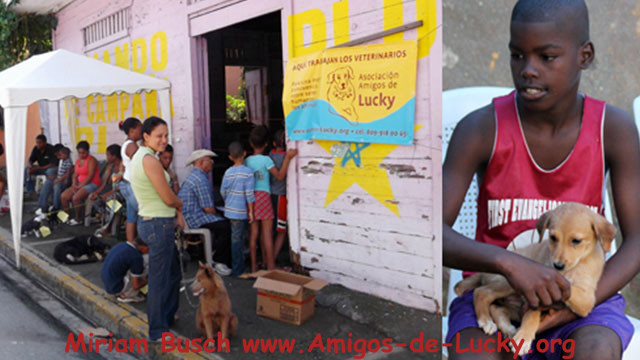 Our spay/neuter campaigns are well accepted by the population and many owners bring their animals to us.
Our spay/neuter campaigns are well accepted by the population and many owners bring their animals to us.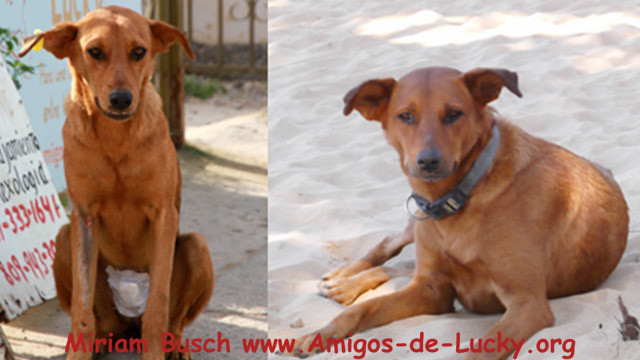 Female stray 2009 after her spaying • 2013 healthy and happy
Female stray 2009 after her spaying • 2013 healthy and happy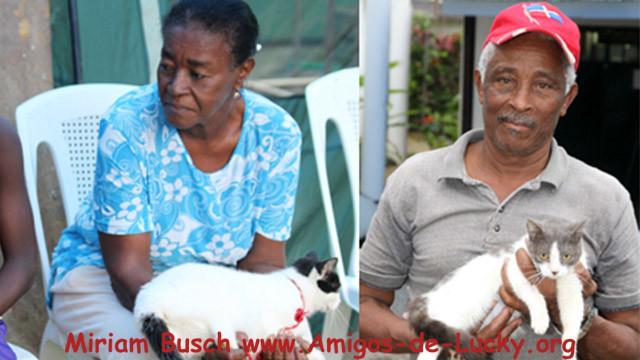
Spaying and neutering
It is essential to control the population of street animals. Here a female dog has about 10 to 20 puppies per year, a cat 8 to 15 kittens, everybody can figure out how many of them will end up on the street, because none of the in majority poor population can feed so many animals. The animals here are sexually mature very early – female dogs sometimes with as young as five months – and the climate is permanently warm, so three litters a year aren’t unusual, meaning females are always either one of the three: in heat, pregnant or nursing. This is a tremendous burden for the animals, they lose weight, their immune system gets weaker and they are therefore especially receptive to illnesses of all kinds (mange, parasitic illnesses, viral infections etc.). Nobody wants an “ugly” or sick dog at home and hence many of the animals with owners get “disposed of” in the streets.
Male dogs and tom-cats are always fighting about the females in heat/season, the results are often bite/scratch wounds, which can get infected very quickly in this humid-warm climate, this in turn leads to a weakening of the body.
In addition females in heat are at a high risk of having accidents. When animals are hormone-driven, they run blindly over the street and don’t mind the traffic. Not only the animals can hurt themselves this way, people can get hurt, too and this doesn’t really improve the overall attitude towards animals.
Spaying and neutering – we focus our attention of spaying the females – are the only ways to end the circle of being in heat, pregnant or nursing once and for all. This way we can gain control of the population and thus reduce the number of street animals considerably. If instead of a gazillion puppies only a couple of hundred are born, those few puppies have a real chance to find a caring and responsible home.
We spay/neuter both strays and animals that have an owner, because unwanted pets can well become the strays of tomorrow.
Educational work
When I first started my educational work it mainly consisted of helping pet dogs survive, because the animals that did have owners often weren’t fed and many of them actually starved to death. A better feeding situation alone however would hardly change anything, so I started – very carefully and never in a know-it-all manner – to draw the attention to the general, but also medical needs of the animals (such as for example deworming, treatment of dermal parasites, spaying/neutering etc.), how important it is to regard the animal as a friend or family member and that an animal can “work” for its living, e. g. a dog can protect a home and family or a cat can catch unwanted rats. I explained that humans and animals can live together in harmony and solidarity and that not only when it comes to one’s own animal. We as humans need to respect and take responsibility for animals and nature, to keep our world in balance.
And of course we don’t just take a stand for dogs and cats but try to help every animal that has suffered injustice through humans, be it a wild snake, turtle, bird or a horse and donkey that have been treated badly by its owners.
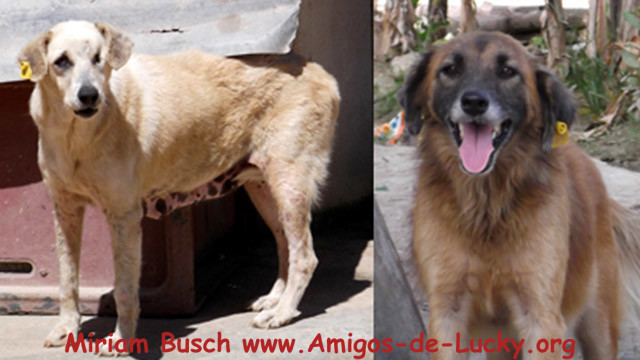 Female street dogs that we spayed a couple of years ago.
Female street dogs that we spayed a couple of years ago.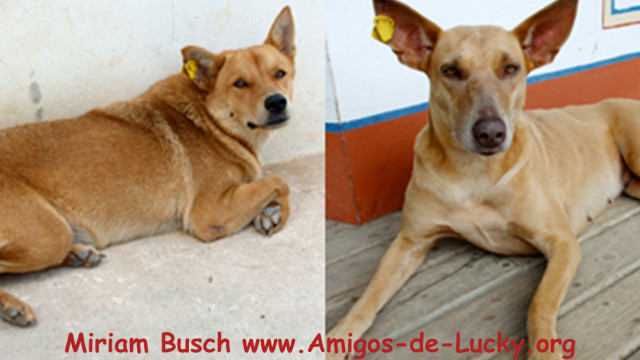 Amber (right) has even been adopted.
Amber (right) has even been adopted.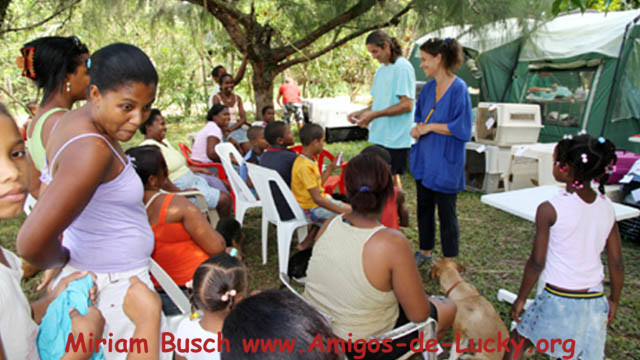 Educational work during a spay/neuter-campaign, to make people understand how important it is to treat their animals in a better way.
Educational work during a spay/neuter-campaign, to make people understand how important it is to treat their animals in a better way.
Our hard path
When we arrived in Las Terrenas/Samana in 2004, hardly anybody touched a dog – kicking them was far more the order of the day. Dogs got pelted with stones to chase them away, poisonous baits were laid out everywhere to control the population, cats (and sometimes even dogs) were eaten, dogs usually didn’t get any older than 5 years of age.
Back then I already made sure that as many female dogs as possible were spayed – a difficult task to undertake, because I often had to drive for hours to the next vet – and I put all my energy into educational work. Often it was like tilting at windmills, hardly were 10 female dogs spayed, when other pregnant dogs or a box with 10 puppies got abandoned in the streets.
Las Terrenas has grown bigger and bigger and many Europeans live here for a longer period of time, at the same time the population of animals has increased rapidly. Unfortunately the same is the case for the number of strays, because many Europeans, who go back to Europe after some time, just leave their animals behind.
2009 it looked like this: every few steps there was a dog on the street, skinny, mangy, covered wounds and scars and obviously ill, often they just died in the open street. Even pure-bred rottweiler, doberman, shepherds or chow chows were now street dogs. Whenever I drove into Las Terrenas (we lived outside on a mountain plot), tears of despair, but also of anger about this situation, filled my eyes. That’s why I founded the Asociación Amigos de Lucky, took all our saved money and started a six-week major spay/neuter campaign, during which we fixed 480 female dogs, 73 male dogs, 72 cats and 16 tom-cats. To make this happen, we took aboard some absolute professionals, German vets, who had made spayings and neuterings for animal protection the purpose of their lives.
They perform sterile operations, and dose intravenous anesthesia pointedly, the cuts are very small (1.2 in to 1.6 in) and still ovaries AND womb are removed (ovariohysterectomy) and usually the procedure doesn’t take more than 20 minutes.
Additionally the animals receive pain killers, a depot-antibiotic, nutritional supplements as well as a medicine against endo- and ectoparasites, they are also sprayed against fleas and ticks. All fixed dogs are tatooed and most of them get an additional yellow ear tag, that later shows a mile off, that the dog is fixed and healthy. Cats have a little triangle cut into their ear to identify them as fixed. Due to the pointedly dosed and short narcosis, the sterile work, resorbable suture material and the small spay- or neuter-scar, the dogs can get back to their proper place in the streets or to their owners immediately, which enables us to fix up to 25 female dogs in one day with only one vet from Vet-Pool.
We set high standards for our spay/neuter-campaigns. Not only the surgery material must be of best quality, our vets as well need to be absolute professionals in their field. Other organizations often employ veterinary students or vets that have only little experience with spayings and neuterings – true to the motto: every fixed animal counts. Although such voluntary work keeps the costs down, we think that street animals aren’t “practice objects” and the safety of the animals has absolute priority.
We rather pay our vets for their professional work and thus have the certainty that the animals are optimally cared for. Street animals can’t come to us by themselves and say, that an operation scar is infected or that the stitching didn’t hold and the Dominican owners don’t look at their animals closely enough, to notice possible upcoming problems after a fixing.
By the way, when owners bring their animals to us to be spayed or neutered, we always ask them for a little support – may it be in form of natural products (often fruits and vegetables, which the people grow in their gardens) or a couple of Pesos – that way the animals become more „valuable“ to them, those who are ready to „pay“ for their animals by experience treat them better afterwards.
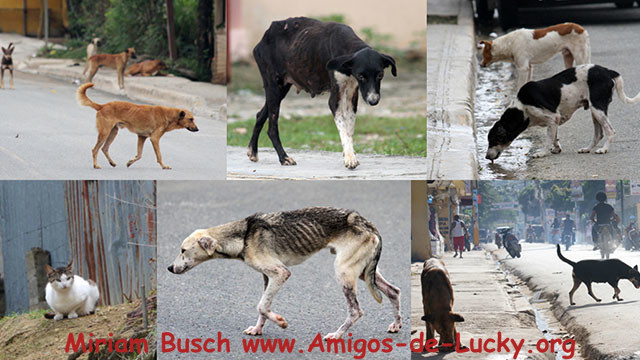 Animals living on the street in the Dominican Republic – Pictures from 2009.
Animals living on the street in the Dominican Republic – Pictures from 2009.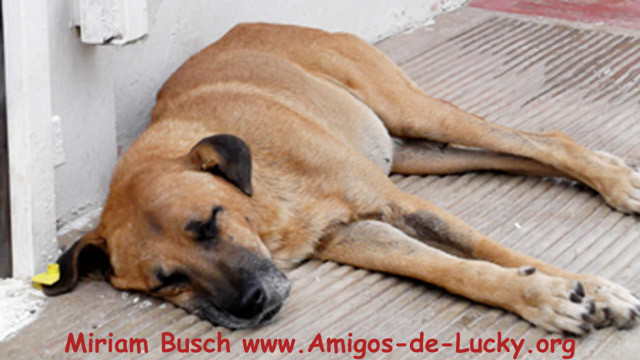 The fixed animals get marked and can – because of the sterile and gentle surgery technics – immediately go back to the street.
The fixed animals get marked and can – because of the sterile and gentle surgery technics – immediately go back to the street.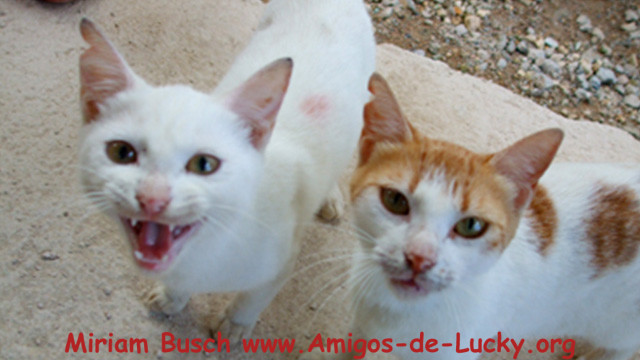
Today
When you walk through Las Terrenas today, you will notice that the number of dogs is tremendously reduced, the majority of the animals is spayed/neutered and healthy and many of the fixed street dogs are more than well fed and happy. Due to the educational work the Dominicans take much more responsibility for their own animal, but also for the abandoned one, they even share their meals with the street dogs.
Again and again I am asked, if it wouldn’t be better to remove all of the dogs from the street and bring them e. g. to an animal shelter. For that you need to know the following: many street animals are animals with owners. Since the Dominicans usually don’t have fenced plots, their animals walk around freely – whilst their owners are at work – they meet conspecifics, play or visit people they like. Street dogs have their steady routines and territories, which they usually defend against newcomers. In a Third World Country where there is no real garbage-concept, garbage often gets disposed of on the curb. Organic garbage is eaten by the dogs and cats, which is good and necessary, because otherwise you would quickly have an overpopulation of rats, which often carry a higher health risk for humans than dogs or cats. Since dogs over here live a free and social life, an animal shelter can’t be species-appropriate. The costs as well would hardly be financeable. The costs for spayings or neuterings are very low (about 70 US$ for a female dog, 40 US$ for a male dog or a cat and 30 US$ for a tom-cat) and help the animal in the long run to live a species-appropriate, healthy and stress-free life.
Because of our relentless work, street animals in Las Terrenas are now a nearly as natural part of the street scape as parking cars. The average age of a dog is no longer only 5 years; there are many gray snouts that lead a calm and placid life with 14 years of age. Fixed and healthy street animals have also much more of a chance of being adopted and thus finding a new home in the long run.
We humans have to say good bye to our “humane” thinking and start to think “animalisticly”. A dog likes a dug sand hole just as well as a 250 US$ little dog bed, for them slaughterhouse waste and bones (which the street dogs get from the local butcher stalls) taste much better and are healthier than dog treats out of a bag, dogs prefer to live freely and with their kind to being kept in a flat by themselves, walks with the pack, where they can play with coconuts together, are more species-appropriate for the animals than a home full of expensive plastic toys. Those who have met the happy street dogs of Las Terrenas and have seen how well they go about with each other and run along the beach or over the street together, don’t need to pity them, they live a species-appropriate dog life. The only important things are that they are spayed/neutered and in good health and that they are respected by the people.
With our work we get down to the root of the problem, with your donations you can contribute to supporting this species-appropriate long lasting animal welfare.